I'm just gonna throw this out there :
[SIZE=8.5pt]MARCH[/SIZE][SIZE=8.5pt] 17, 2020[/SIZE]
[SIZE=12pt]The coronavirus that originated in Wuhan, China, has now swept through 126 countries, infected close to 170,000 people worldwide, and is responsible for more than 6,400 deaths as of March 15. China is leading the world in the number of confirmed cases and deaths. What many people find shocking is that Italy and Iran are the second- and third-hardest hit nations in this outbreak.[/SIZE]
[SIZE=12pt]By any common-sense measure, both countries should have much lower numbers of confirmed cases and deaths because they are geographically far from the epicenter of the outbreak. The reason these two countries are suffering the most outside China is mainly due to their close ties with Beijing, primarily through the “
One Belt and One Road” (OBOR) initiative.[/SIZE]
[SIZE=12pt]OBOR is Beijing’s foreign policy play disguised as infrastructure investment. Here’s how it works: China and country X agree to do an infrastructure project in country X. Country X has to borrow from a Chinese bank to finance the project. A contract is always awarded to Chinese companies, which then bring supplies and Chinese employees to country X to build the project. Clearly, the country that benefits most from this initiative is China.[/SIZE]
[SIZE=12pt]The OBOR provides new markets and consistent demand for China’s goods and services, creates employment opportunities for Chinese workers, and gives China access to strategically important locations and natural resources. Beijing’s real objective is to leverage its newly gained financial power to greatly expand its geopolitical influence as well as its economic and military footing from Asia to Europe and Africa.[/SIZE]
[SIZE=12pt]While this initiative has worked out well for China’s strategic interests, it hasn’t done the same for participating countries. At least eight countries that signed on the OBOR initiative are so indebted to the Chinese that they had to
hand over their strategic assets to China to offset their debt. Despite these worrisome precedents, leaders in both Italy and Iran eagerly signed up to OBOR in 2019, hoping the red capital from Communist China would rescue their nations from economic woes. Now they are paying a dear price for it.[/SIZE]
[SIZE=12pt]What Has Happened in Italy[/SIZE]
[SIZE=12pt]Italy’s economy has been struggling for two decades. It has seen three
recessions in 10 years. Its unemployment rate stood at
10.3 percent, and its youth unemployment rate was 33 percent as of 2018.
According to Marco Annunziata of Forbes, the living standards in Italy today are roughly the same as they were 20 years ago because very little growth has occurred.[/SIZE]
[SIZE=12pt]Italy’s economic woes are caused by aging industries, ruinous regulations (especially its
overly rigid labor laws), an inefficient banking system, high levels of corruption, and constant political turmoil. From 1946 to 2016, Italy had
65 governments. No matter who was in charge, he lacked resolve to implement serious structural reform and deregulation to boost the economy.[/SIZE]
[SIZE=12pt]Instead, every one of the 65 governments hoped they could spend their way out of an economic mess. Italy’s debt burden as a percentage of annual economic activity measured by GDP is at 132 percent as of 2018, the second highest in the EU, only slightly better than Greece.[/SIZE]
[SIZE=12pt]The most recent political upheaval in Italy took place in May 2018. Weeks after an election, the anti-establishment groups and pro-EU lawmakers failed to produce a new coalition government. The final compromise resulted in a virtually unknown law professor, Giuseppe Conte, becoming the new prime minister.[/SIZE]
[SIZE=12pt]Like his predecessors, Conte has been unwilling to implement any structural reform. Instead, he sought an “easy” way out. Almost exactly a year ago in March 2019, against warnings from the EU and the United States, Italy became
the first and only G7 country to sign onto OBOR. As part of the deal, Italy opened an array of sectors to Chinese investment, from infrastructure to transportation, including letting Chinese state-owned companies hold a stake in four major Italian ports. The deal gave communist China a foothold in the heart of Europe, but Conte downplayed it as “no big deal at all.”[/SIZE]
[SIZE=12pt]Lombardy and Tuscany are the two regions that saw the most Chinese investment. Nearly a year later, the first Wuhan coronavirus infection case in Italy was reported in the Lombardy region on Feb. 21. Today, Italy is experiencing the worst coronavirus outbreak outside China, and Lombardy is the hardest-hit region in the country. As of March 14, Italy
reported 24,747 cases and 1,809 deaths. Now the entire country is in lockdown until at least April 3. Its economy is expected to
contract 7.5 percent in the first quarter, opposite what Conte had hoped.[/SIZE]
[SIZE=12pt]What Has Happened in Iran[/SIZE]
[SIZE=12pt]Iran faces some of the worst economic and political challenges it has in decades. The Trump administration re-imposed economic sanctions in 2018, which has worsened an already crumbling economy. In 2019, Iran’s inflation rate was 40 percent. The regime had to introduce a ration to limit meat consumption last year. Its currency, the rial, has lost 70 percent of its value to U.S. dollars. The overall unemployment rate was 15 percent but between 40 and 50 percent among young people.[/SIZE]
[SIZE=12pt]Fed up with economic hardship, Iranians took to the streets in late 2017 to 2018 and then again between 2019 and early 2020. Initially, they protested to voice economic grievances about government corruption, but the protests quickly shifted to demands for fundamental political reform. They rejected their government’s policy of supporting terrorists in countries like Syria while ignoring economic hardship at home, and called both for Supreme Leader Ayatollah Ali Khamenei to step down and for “death to the Revolutionary Guards,” a powerful military force loyal to him.[/SIZE]
[SIZE=12pt]The Iranian government responded to these protests with an iron fist. In 2019 alone, the Iranian government
reportedly killed more than 1,000 protesters, arrested thousands more, and shut down internet nationwide for six days to block news of the crackdown from being shared domestically and internationally.[/SIZE]
[SIZE=12pt]Facing domestic economic and political challenges and international isolation, Iran has sought out China as an ally against the United States, relying on economic ties and military cooperation with Beijing to fend off U.S.-imposed sanctions. China has been keeping the Iranian regime afloat by purchasing Iranian oil, selling the Iranian regime weapons, and transferring nuclear technologies.[/SIZE]
[SIZE=12pt]But 2019 was the year Iran officially signed up to OBOR. China sees Iran as a crucial player to this initiative because Iran is not only rich in oil but also lies in a direct path of an ambitious 2,000-mile railroad China wants to build, which will run from western China through Tehran and Turkey into Europe.[/SIZE]
[SIZE=12pt]Today, Iranian health officials trace the country’s coronavirus outbreak to Qom, a city of a million people.
According to the Wall Street Journal, “China Railway Engineering Corp. is building a $2.7 billion high-speed rail line through Qom. Chinese technicians have been helping refurbish a nuclear-power plant nearby.” Iranian medical professionals suspect either Chinese workers in Qom or an Iranian businessman who travelled to China from Qom caused the spread of the coronavirus in Qom.[/SIZE]
[SIZE=12pt]But religious leaders and the Iranian government were slow to take action. Religious leaders in Qom refused to cancel Friday prayers until the end of February, which allowed infected pilgrims to quickly spread the virus to other parts of the nation. Although on Feb. 1 the Iranian government banned its airlines from flying to China, it made an exception for Mahan Air, an unofficial airline for the Islamic Revolutionary Guard Corps.[/SIZE]
[SIZE=12pt]The WSJ
reported that Mahan Air “had carried out eight flights between Tehran and China between Feb. 1 and Feb. 9 to transfer Chinese and Iranian passengers to their respective home countries.” This explains why so many high-level Iranian officials are infected by the coronavirus, including First Vice President Eshaq Jahangiri and more than 20 lawmakers. Mohammad Mirmohammadi, an adviser to Khamenei, was the most senior Iranian official who died of the coronavirus as of today.[/SIZE]
[SIZE=12pt]Iran is now the third-worst hit country in the coronavirus pandemic, with close to 14,000 cases and 724 deaths. Given the secretive nature of the regime, many suspect the actual numbers of cases and deaths are much higher. Ilan Berman, vice president of the American Foreign Policy Council,
says, “Coronavirus has exacted an even higher political toll on the regime, because it has exposed the country’s ruling clerical elite as incompetent and out-of-touch.” He predicts the coronavirus may accomplish what years of actions by the West have failed to achieve: the collapse of Iran’s clerical authoritarian regime.[/SIZE]
[SIZE=12pt]Italy and Iran have very different social, economic, and political systems. Yet both nations share something in common: Their leaders refused to implement economic and political reforms in their nations. Instead, they sought close ties with communist China in recent years, selling out their countries and their people’s interests, hoping Beijing’s red capital would rescue their failing economies. Now their economies are worsening and their people are suffering most in this outbreak — all because of these leaders’ short-sighted and foolish decisions.[/SIZE]
[SIZE=12pt]Helen Raleigh is a senior contributor to The Federalist. An immigrant from China, she is the owner of Red Meadow Advisors, LLC, and an immigration policy fellow at the Centennial Institute in Colorado. She is the author of several books, including "Confucius Never Said" and "The Broken Welcome Mat." Follow Helen on Twitter @HRaleighspeaks, or check out her website: helenraleighspeaks.com.[/SIZE]









